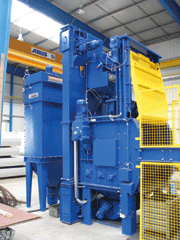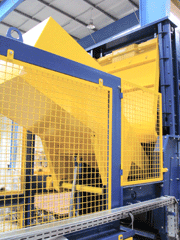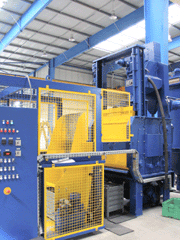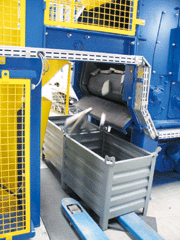E-Archive
Articles
in Vol. 6 - September Issue - Year 2005
Annealing Is Done First, Then Blasting

Tumble blast machine with loading device and filter system

Tumble blast machine with loading device

Tumble blast machine with loading device

View into the tumble blast machine

Deloading into containers
Debus GmbH of Buschhütten is a single source for both annealing and blasting services. Fast turnover times and flexibility are top priorities.
The beginnings were not only modest, they were also driven by necessity. Faced with the impending demise of their employer, a father-and-son team quickly launched their own company. Their names: Robert and Frank Debus. Their company: Debus Glühen, Wärmebehandlung, Sandstrahlen GmbH. This specialist in annealing, heat treatment and sand blasting was founded on April 1, 1996 at the former SMS property in Buschhütten.
Heat treatment
When they first turned their attention to annealing – that is, the “relaxation” of welded machine components and rolled aluminum billets – Debus’ founders were in no way satisfied with the prevailing standard. In order to satisfy their demanding goals, it was necessary to develop and build an oven whose annealing temperature could be controlled with a precision of just a single degree. The company’s founders — both trained machine fitters — have since added four of these ovens with a total capacity of 210 tons to their complement of equipment.
Temperatures reach up to 1000 degrees in the modern and high-performance ovens, which are equipped with fully automatic programming and ultra-precise temperature control. Precision sensors regulate the temperature and control the oven. Chart recorders (12 color recorders) also record all of the data necessary for the quality-control process. If desired by customers, annealing diagrams and annealing certificates are supplied with each delivery.
Blasting technology
In order to keep pace with fast-moving developments in sandblasting, father and son also acquired a structural blasting unit. “One of the largest in Germany and the only one of its kind in the vicinity,” they emphasize. The free-hand blasting facility was also expanded. Here, larger machine components and complicated structural components, which, for example, must be blasted on the inside, are hand blasted precisely and exactly.
In order to blast not only large work pieces, but also smaller parts and — above all — a large variety of components, father and son recently invested in a new tumble blast unit manufactured by AGTOS of 48282 Emsdetten.
Pressing a button on the control panel activates a loading mechanism that directly loads the blasting machine. After the door is automatically closed and secured against accidental opening, the pre-defined blasting process begins. When the blasting process ends, the door opens automatically and work pieces are incrementally emptied directly into waiting containers.
The AGTOS high-performance turbine — the heart of the blasting unit
The unit installed at DEBUS contains a Type 3.6 high-performance turbine. It is equipped with a single-disk turbine that has decisive advantages over the double-disk designs prevalent in the marketplace. There are no spacer bolts between the two turbine wheels. These bolts disturb the flow of abrasive and cause turbulence. A further reduction in the number of wear-susceptible parts was achieved by using six instead of eight discharge blades. This cuts costs and has a positive impact on the performance of the equipment.
A wear-resistant cover protects the elaborate mounting disk for the blades. This saves on the cost of spare parts. Favorable flow characteristics inside the turbine make possible a higher level of performance than in comparable double-disk machines — although the level of power consumption is the same. Additional advantages include ease of maintenance and a long service life for components.
Maintenance- and environmentally-friendly cartridge filter system
The filter technology also sets new standards and makes a significant contribution to process safety. Dust-laden air is extracted from the blasting chamber and flows through the impact separator, where the initial separation of heavy dust particles occurs. After this, dust enters the lower filter chamber. Dust is removed as the air flows through the filter cartridges and clean air then flows upward into the clean gas chamber.
The filter cartridges are cleaned by pulses of compressed air. The cleaning process takes place as a function of differential pressure. This protects the filter cartridges and extends their service lifetime. Falling dust particles are fed to a hopper located beneath the filter, where they are gathered in a metal collection container. Clean air is released to the outside environment through the upper part of the filter housing or is returned back to the production hall. Should a filter cartridge be destroyed, additional filter inserts collect the dust to the greatest extent possible.
The filter cartridges have a conical shape because this permits the compressed air impulse to more directly impact the inside of the side walls and the attached coating of dust. In comparison to other cartridge types, the overall area of the filter surface is smaller. However, the special structure of the filter medium makes it possible to draw more air per m2 through the cartridge. In addition, the use of a rougher fold provides for better dust adhesion and cleaning because the dust is dislodged more easily by the compressed air impulse.
In comparison to the cylindrical sidewalls of conventional filter cartridges, the conical shape of the filter cartridges alone is enough to achieve a better utilization of the compressed air pulses. The disposal process illustrates yet another advantage: the loading-bearing metal body of the filter cartridge is reusable. Only the filter medium requires disposal. Depending on the type of dust collected, the dust can usually be burned or disposed of as common industrial waste. This eliminates additional disposal costs.
Newly developed slide-in inserts simplify the exchange and replacement of cartridges. The cartridges are pulled from the filter unit and can then be replaced outside the filter in a clean environment. The cartridges are still precisely positioned when reinserted and always install with the proper contact pressure.
With their new machines, father and son are able to offer an annealing and blasting service that can treat components within a two-day period. “Speed and flexibility are our top priorities,” emphasizes the younger partner. Roughly 500 customers from all parts of Germany now profit from this commitment to quality.
Numbers impressively document the positive developments at the company. In a series of four expansion phases, floor space has increased ten-fold from its original 300 square meters and the number of employees has grown to thirteen. This company has a rosy future — thanks in large part to modern annealing and blasting technology.
AGTOS
Gesellschaft für technische
Oberflächensysteme GmbH
Gutenbergstr. 14, 48282 Emsdetten, Germany
Tel. +49.2572.96026-0
Fax +49.2572.96026-111
www.agtos.com, E-Mail: info@agtos.de



























